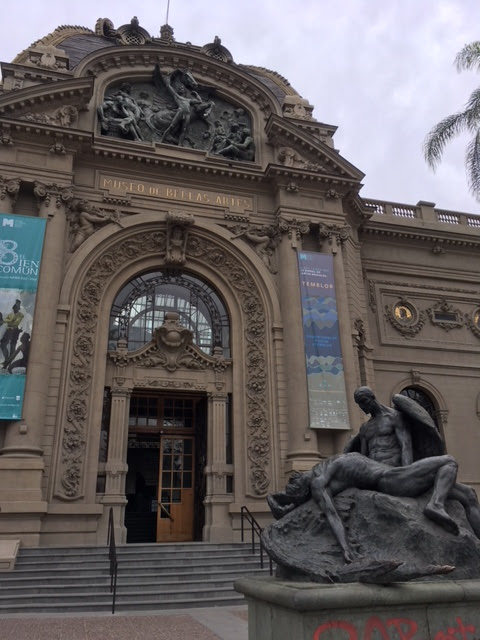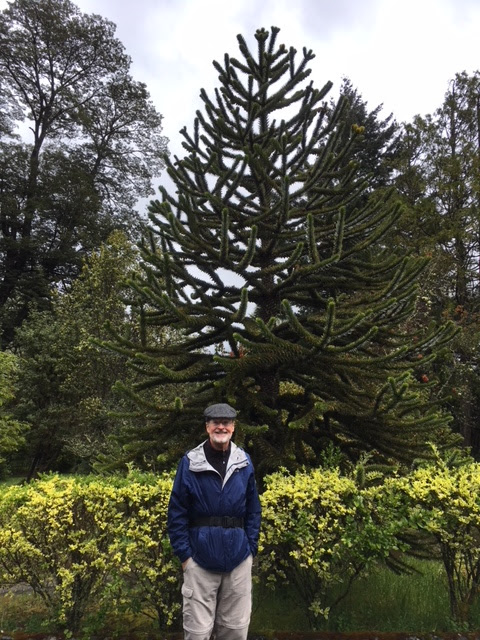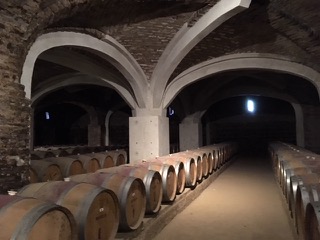On our first day we were on our own. We walked to a huge, indoor, very modern mall for lunch and to find an ATM. Paul is marveling at the height of the Christmas tree. Those are escalators to the various floors in back of him.
We visited the National Fine Arts Museum. An impressive building architecturally, but unfortunately very unimpressive collection. Then we enjoyed walking through a park in the middle of the downtown area - like a small version of Central Park in NYC.
The next day we met up with our group of 12. We had lunch at Santiago’s Central Market, a large indoor market area built in the 1800’s, still with restaurants and shops. Then we walked around the historical center. Great blend of old and new government buildings, offices, cathedrals, etc.
After walking around, we drove up a hillside to get a view of the city. That tall building is the tallest in all of Central and South America.
The next day, we went to the Museo de Arte Precolombino. This place is incredible. It’s considered one of the most important museums in the world dedicated to cultures that existed before the Spanish arrived to Central and South America. A guide talked to us about some of the items but there wasn’t enough time to see as much as we would have liked. Paul and I will return when we’re in Santiago again at the end of the trip.Santiago is a busy modern city of about 6.5 million, but it has a much more relaxed feel to it than our big cities.
These are headdresses that distinguished various indigenous peoples and their positions. Items were in incredible condition because they were from extremely dry desert areas.
Quipus were series of strings with knots in them, worn around the waist, that were used for accounting and data collecting. This is the largest that’s ever been found in the world.
Pottery was amazing.
These totems, called Chemamulles, were placed on top of graves.
The next day was a very interesting day. We drove out to the Pacific coast for a private tour of a small (350 acres) family-owned vineyard. We learned all about how the family got started and has continued for generations, about the grape vines, their wine making process, and then had a wonderful lunch with wine pairings. My photo doesn’t pick up how even the hillsides are terraced with grape vines.
We then drove to the historic port city of Valparaiso. We toured the funky 5-story seaside home of Pablo Neruda, Chile’s most famous poet and Noble Prize laureate.
There’s lots of street art/graffiti throughout the city - a lot of it quite remarkable.
Valparaiso is a very vertical city with a mix of humble dwellings hanging on the sides of steep streets and ridges ....
... as well as government buildings, hotels, shops and restaurants. A particularly interesting building is the one to the right of center in this photo. A city regulation required historic buildings to maintain the same facade if they were to be renovated. That square modern building that looks like it’s behind the old one is actually in the middle of it! The exterior facade was kept and a whole new modern building was built inside it. So funny.
The next morning we flew to Puerto Montt and drove though areas of modest homes and beautiful countryside with the towering Andes in the background. The fish and handicraft market is seaside and more rustic than the ones we’ve been to previously.
Sea lions enjoyed getting fish scraps that were tossed to them.
As we were driving along the shore of Lake Llanquihue, we stopped for this photo op of the lake with views of the snow-capped volcanoes, Osomo and Calbuco. Some light rain started as soon as we got back on the bus.
The next day, we sailed around the lake on an enclosed catamaran. Unfortunately the weather was rainy so clouds obstructed views of the snow capped peaks.
I took this photo through the window quite some distance from these 400’ tall waterfalls. We got right up close to them - very impressive.
It’s Spring here now so trees are in bloom. Here’s a Crabapple Tree and a Flame Tree - indigenous to this area. Temperatures have been in the 60’s but the weather can change very quickly so we dress in layers so we’re ready for anything.
This is a Monkey Puzzle Tree - also indigenous to this area.
We did a little hiking in a small hamlet called Peulla where we also had lunch.
We visited Petrohue Falls where one large area had a succession of rapids thundering over volcanic rocks. It was awesome! Here's a very short video ....
Typical buildings in the city ...The next day was a long travel day. We took an hour and a half flight to Punta Arenas, Chile’s southernmost city, on the Strait of Magellan opposite Tierra Del Fuego. It was founded in 1848, in its golden age it was a port-of-call for all ships going around the world. We had lunch at a very nice hotel and then had a guided walking tour of the city.
A very nice central park with the expected statue of Magellan ....
And from a higher point, a view across the strait named after him to Tierra del Fuego -- the southern tip of South America named "Land of Fire" by the Spaniards.
Homes on the hillside outskirts of the city are modest.
This is a view of the city from atop one of the hillside neighborhoods.
This is what the overhead electrical lines looked like in many parts of the city. Yikes.
From Punta Arenas we drove 2 1/2 hours across the Patagonian Pampas to our hotel in Puerto Natale. Flat, grazing land as far as the eye can see! We’ve since had a busy, spectacular couple of days. Weather has been perfect - high 60’s with blue skies and sunshine.
We all took a boat across a large inlet connected to the sea, to Bernardo O'Higgins National Park. On the way across, we enjoyed seeing these sea lions.
One other woman and I chose to stay on the boat to continue up one of the fjords to do some hiking in the Bernardo O’Higgins National Park with a guide and get up close to a glacier. Our guide was fantastic, and it was great!

Paul chose to do horseback riding, which he also greatly enjoyed.
Then we all went to a sheep station for sheep herding and shearing demonstrations. We also had lunch here (yes, lamb, which had been grilled outside for 4 hours-delicious).
It’s the season for lambs to be born. This one had been born that very morning that we were there and was already getting around just fine.
We drove to Torres Del Paine National Park, described as “the most impressive sight in southern Chile .... known as the crown jewel of Patagonia”. It covers an area of 600,000 acres with dramatic mountain formations, lakes and lagoons, waterfalls, glaciers, ice fields and vast expanses. I can’t adequately describe how awesome it is. We drove around to a number of great lookouts, did some hiking
This friendly armadillo knew that underneath picnic tables was a great place to find food.
This large Cara Cara hawk swooped down right over our heads, landed and hung around for a while, probably also waiting for food.
Here are some other wonderful scenes from the park.
The spectacular Torres Del Paine (Towers) have giant granite peaks.
 Guanacos are like deer, and are all over Torres del Paine National Park.
Guanacos are like deer, and are all over Torres del Paine National Park.Later in the afternoon we visited Cueva Del Milodon, an enormous cave where Professor Dillehay had done some excavating, finding evidence of animals and people from 14,000 to 16,000 years ago.
This cave is considered one of the two most important sites of early human habitation in all the Americas.
Professor Dillehay has been such a gift on this trip. He’s been with us constantly every day providing information and commentary on the spot and answering questions. He gave 3 formal lectures of about an hour each, and enhanced our dinners with friendly, jovial camaraderie.
The next morning, we flew 4 hours back to Santiago.
We visited another winery, about 45 minutes from the city.
Although the vineyards looked the same, everything else was on a much larger scale than the family winery we had visited earlier. This was the 3rd largest wine producer in Chile.
The aging cellars seemed to go on forever.
After the tour, we enjoyed a delicious lunch ...
... with excellent wine pairings ...
... and great desserts!
For our final group outing, we visited the Human Rights Museum in Santiago, where exhibits and artifacts tell the sad story of human rights abuses preceding and during the period in the 1980s when Chile was ruled by an authoritarian military government. Since the end of military rule, Chile seems to have developed a stable and robust democratic institutions, and currently is viewed as the most politically stable and economically advanced nation in Latin and South America.
Everyone else is leaving Friday night, but we are staying an extra day to get the nonstop flight to New York on Saturday night, arriving home early Sunday morning. It has been one heckuva' trip!
***THE END***




















































